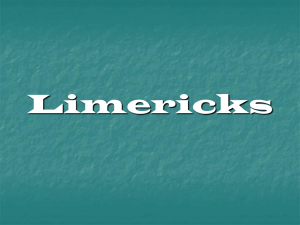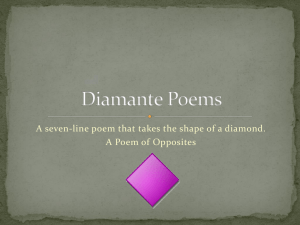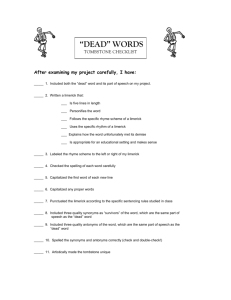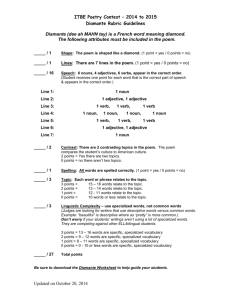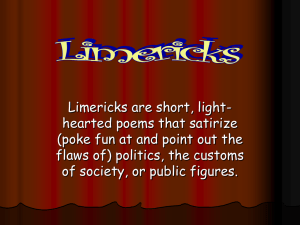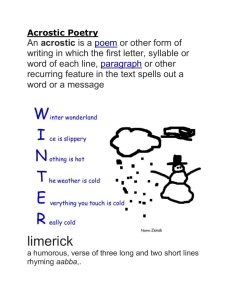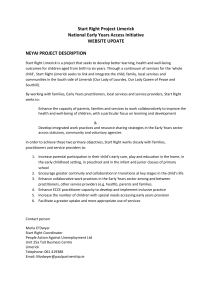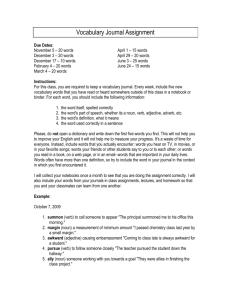Grade 7 - SchoolRack
advertisement
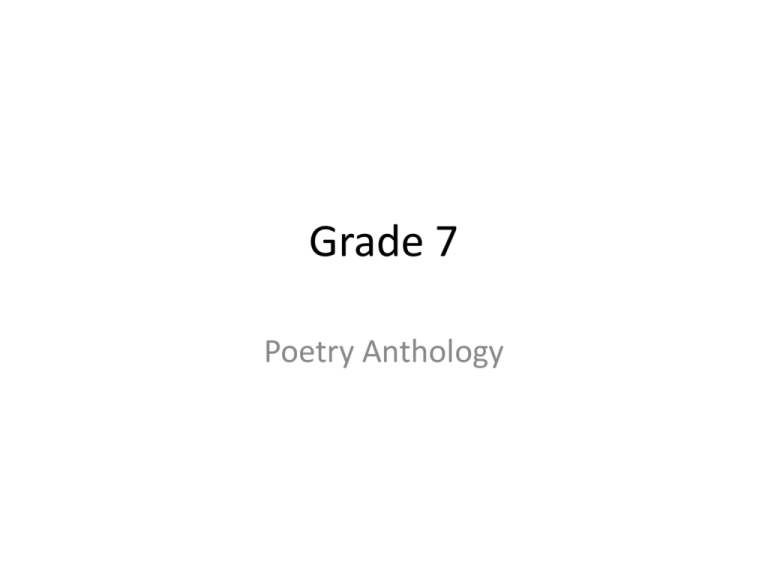
Grade 7 Poetry Anthology Cinquain • What is a cinquain? • At the most basic level a cinquain is a five line poem or stanza. • The poem has one topic and the details describe the the topic's actions and feelings. Line 1 - one word for the topic Line 2 - 2 words to describes your topic Line 3 - 3 words that describes the actions relating to your topic Line 4 - 4 words that describes the feelings relating to your topic Line 5 - one word that is another name for your topic Haiku • Haiku (俳句 high-koo) are short poems that use sensory language to capture a feeling or image. They are often inspired by an element of nature, a moment of beauty or a poignant experience. Haiku poetry was originally developed by Japanese poets, and the form was adapted to English and other languages by poets in other countries. A haiku is an unrhymed three-line poem. Format Line 1: 5 syllables Line 2: 7 syllables Line 3: 5 syllables Or Winter is coming. Snow will be arriving soon. We should rake the leaves. Limerick • What is a Limerick? • Limericks are one of the most fun and wellknown poetic forms. No one knows for sure where the name “limerick” comes from, but most people assume it is related to the county of Limerick, in Ireland. • The reason limericks are so much fun is because they are short, rhyming, funny, and have a bouncy rhythm that makes them easy to memorize. Limerick • The Rules of Limericks: • Limericks, like all poetic forms, have a set of rules that you need to follow. The rules for a limerick are fairly simple: • They are five lines long. • Lines 1, 2, and 5 rhyme with one another. • Lines 3 and 4 rhyme with each other. • They have a distinctive rhythm (which I’ll explain shortly) • They are usually funny. Limerick • The rhyme scheme of a limerick is known as “AABBA.” This is because the last words in lines 1, 2, and 5 rhyme. Those are the “A’s” in the rhyme scheme. The “B’s” are the last words of lines 3 and 4. Let me give you an example: There was a young fellow named Hall Who fell in the spring in the fall. ‘Twould have been a sad thing Had he died in the spring, But he didn’t—he died in the fall. – Anonymous • Notice that the words, “Hall,” “fall,” and “fall” all rhyme. Those are the “A” words in the “AABBA” rhyme scheme. Also notice that “thing” and “spring” rhyme. Those are the “B” words in the rhyme scheme. Limerick • Limerick Rhythm: • Now let’s take a look at the rhythm of the limerick. It goes by the complicated name “anapaestic,” but you don’t need to worry about that. What I want you to notice when you read or recite a limerick is that the first two lines and the last line have three “beats” in them, while the third and fourth lines have two “beats.” In other words, the rhythm of a limerick looks like this: da DUM da da DUM da da DUM da DUM da da DUM da da DUM da DUM da da DUM da DUM da da DUM da DUM da da DUM da da DUM Limerick • The rhythm doesn’t have to exactly match this, but it needs to be close enough that it sounds the same when you read it. For example, using the limerick above about the fellow from Hall, if we emphasize the beats, it reads like this: there WAS a young FELLow named HALL who FELL in the SPRING in the FALL. ‘twould have BEEN a sad THING had he DIED in the SPRING, but he DIDn’t—he DIED in the FALL. Limerick • Let’s take a look at another famous limerick: There was an old man of Nantucket Who kept all his cash in a bucket; But his daughter, named Nan, Ran away with a man, And as for the bucket, Nantucket. – Anonymous • • If you emphasize the beats when you read it, it comes out like this: there WAS an old MAN of NanTUCKet who KEPT all his CASH in a BUCKet; but his DAUGHTer, named NAN, ran aWAY with a MAN, and AS for the BUCKet, NanTUCKet. Limerick Some Limerick Tricks • There are two more things that you will notice when you read limericks: 1.The first line usually ends with a person’s first name or the name of a place. 2.The last line is usually funny. Free Verse • Free verse is an open form of poetry. It does not use consistent meter patterns, rhyme, or any other musical pattern. It thus tends to follow the rhythm of natural speech. Free Verse • Choosing Words Carefully: Carefully chosen words can help you create a poem that sounds like the situation, emotion, or object you are trying to portray. For instance, short words with sharp consonants cause the reader to stop-and- go in a choppy cadence: Cut, bash, stop, kick, lick, bite, punch, jump, stick, kiss. They almost sound like what they mean. Use these types of short words when you want to show excitement, fear, anger, new love, or anything that might make your heart beat quickly. Longer words with soft sounds cause the reader to slow down. Use them when you want to show pause, tension, laziness, rest. Concrete • What is a Concrete Poem? Concrete poetry—sometimes also called ‘shape poetry’—is poetry whose visual appearance matches the topic of the poem. The words form shapes which illustrate the poem’s subject as a picture, as well as through their literal meaning. Concrete Diamante • A diamante – pronounced dee-uh-MAHN-tay – is an unrhymed seven-line poem. The beginning and ending lines are the shortest, while the lines in the middle are longer, giving diamante poems a diamond shape. “Diamante” is the Italian word for diamond, so this poetic form is named for this diamond shape. • Also known as a “diamond poem” because of it’s shape, there are two different types of diamantes; synonym diamantes and antonym diamantes. • Also known as a “diamond poem” because of it’s shape, there are two different types of diamantes; synonym diamantes and antonym diamantes. Diamante • • • • • • • • The Rules of a Diamante: There are just a few rules to writing a diamante: Diamantes are seven lines long. The first and last lines have just one word. The second and sixth lines have two words. The third and fifth lines have three words. And the fourth line has four words. Lines 1, 4, and 7 have nouns. Lines 2 and 6 have adjectives. Lines 3 and 5 have verbs. Here’s an easy way to visualize all three rules: Noun Adjective, Adjective Verb, Verb, Verb Noun, Noun, Noun, Noun Verb, Verb, Verb Adjective, Adjective Noun Diamante Here’s an easy way to visualize all three rules: Noun Adjective, Adjective Verb, Verb, Verb Noun, Noun, Noun, Noun Verb, Verb, Verb Adjective, Adjective Noun In a synonym diamante, the nouns at the beginning and end are two words that mean basically the same thing. In an antonym diamante, the two nouns are opposites. Here are a couple of examples: In this diamante, the words “Monsters” and “Creatures” mean the same thing, so they are synonyms. Monsters Evil, Spooky Howling, Shrieking, Wailing Ghosts, Vampires, Goblins, Witches Flying, Scaring, Terrifying Creepy, Crawly Creatures Antonym Diamante: In this diamante, you might say that the words “Cat” and “Dog” are opposites, or “antonyms,” so this is an antonym diamante. Cat Gentle, Sleepy Purring, Meowing, Scratching Whiskers, Fur, Collar, Leash Barking, Licking, Digging Slobbery, Playful Dog One Poem of Your Choice! Have Fun!
